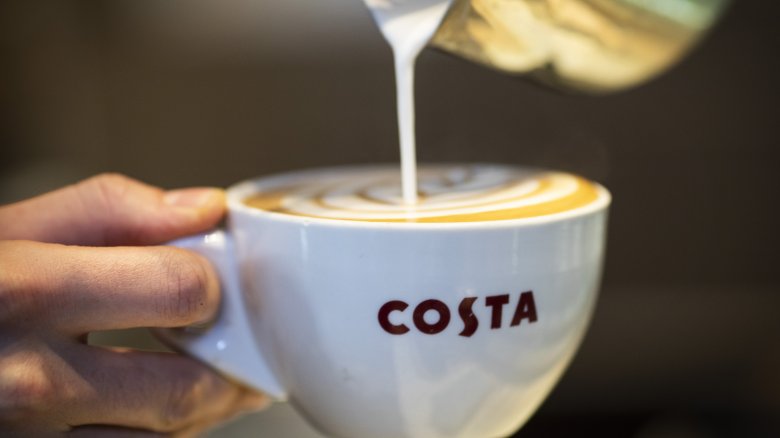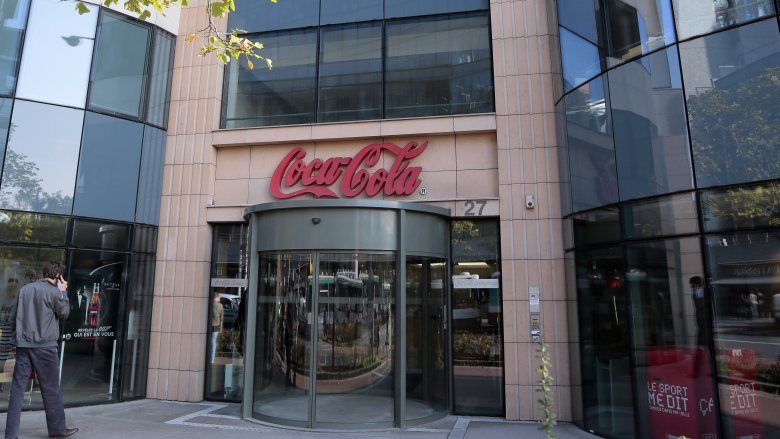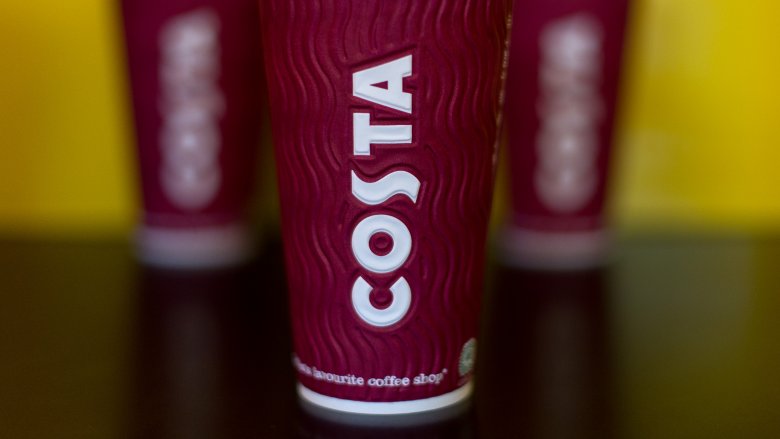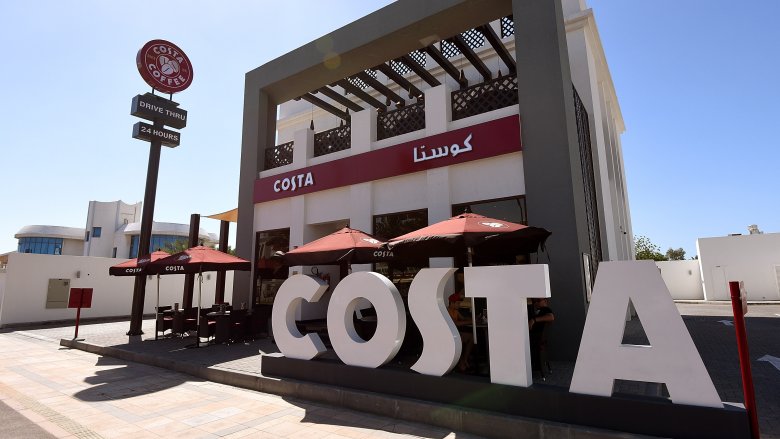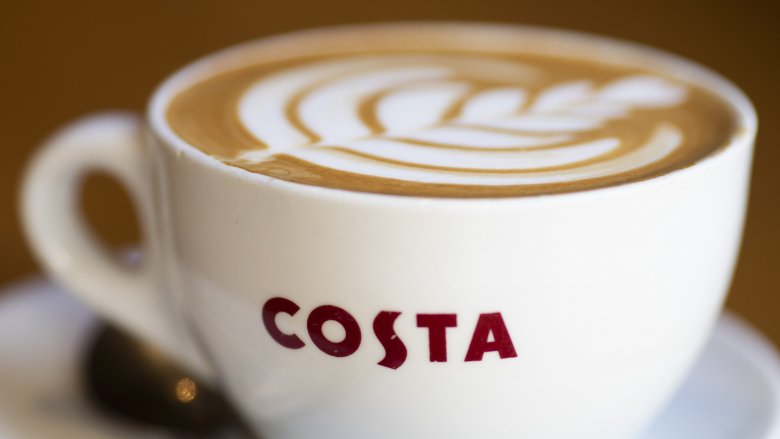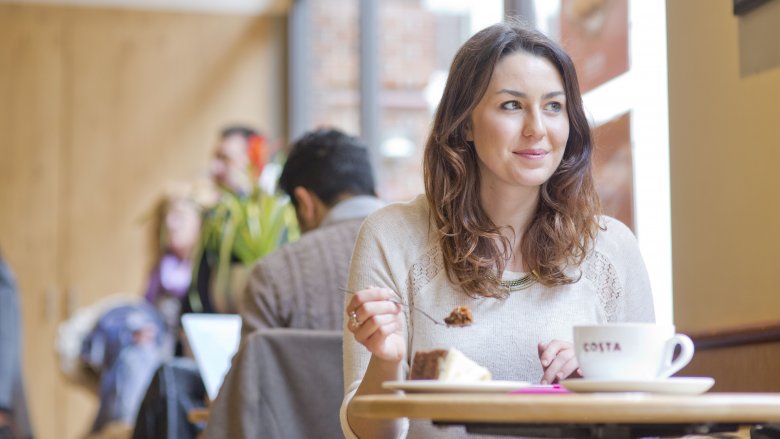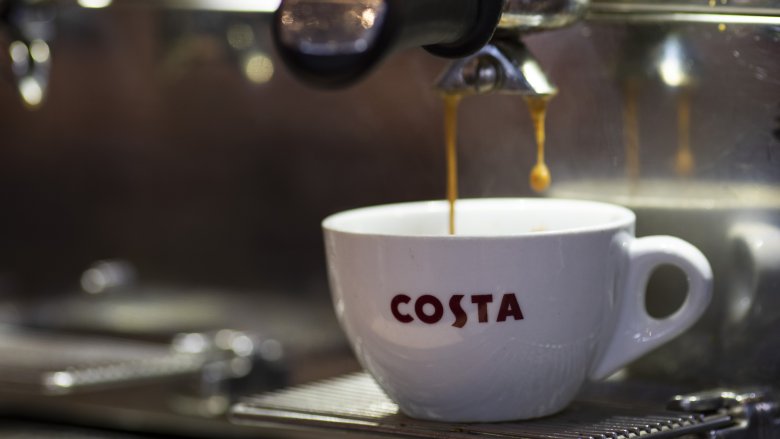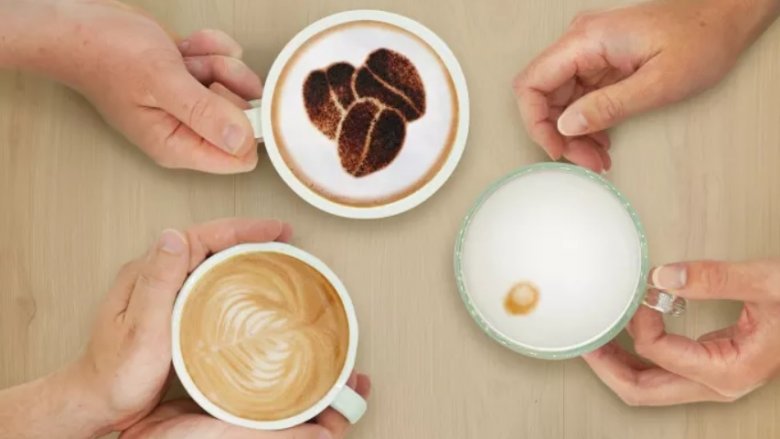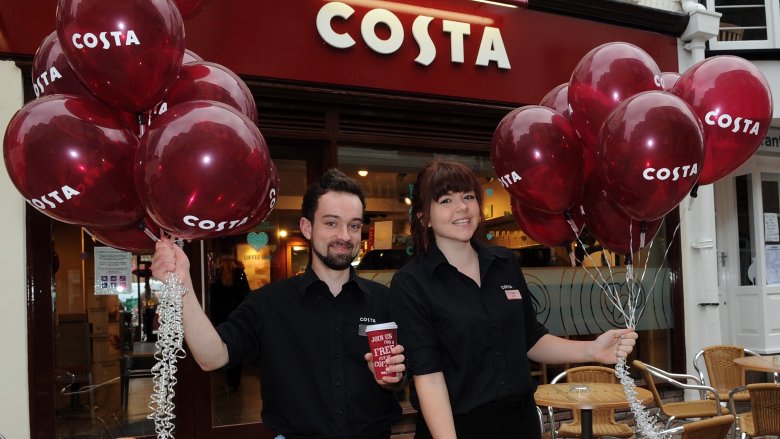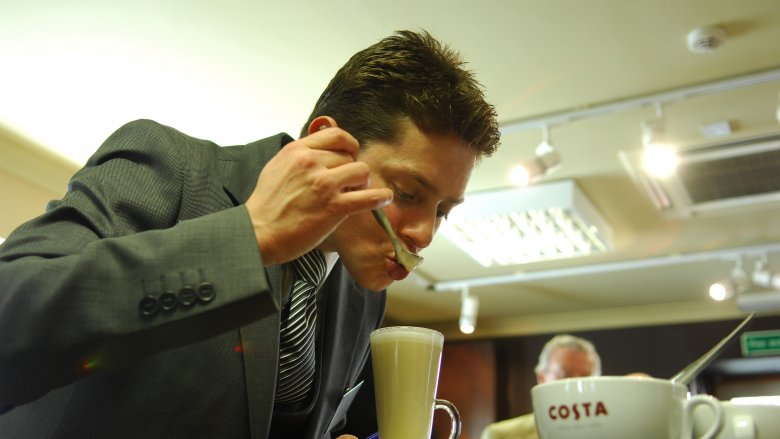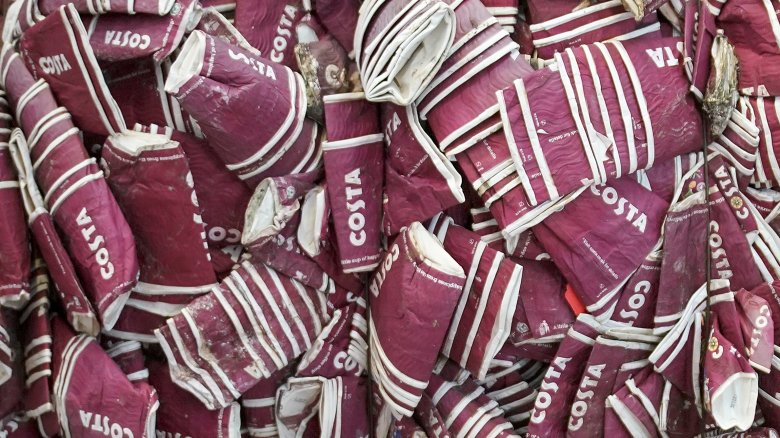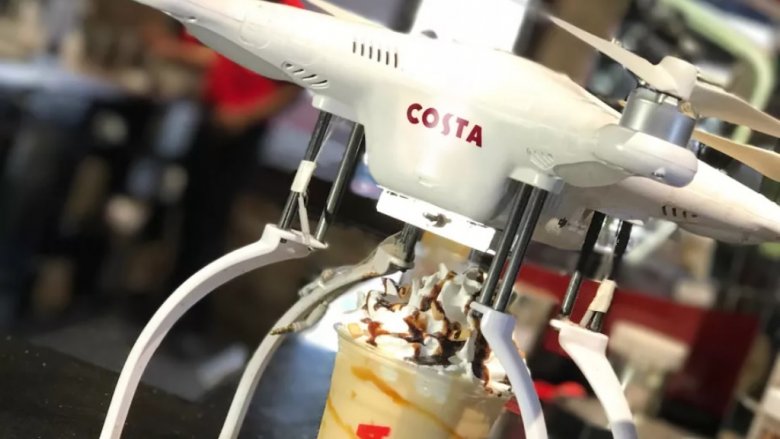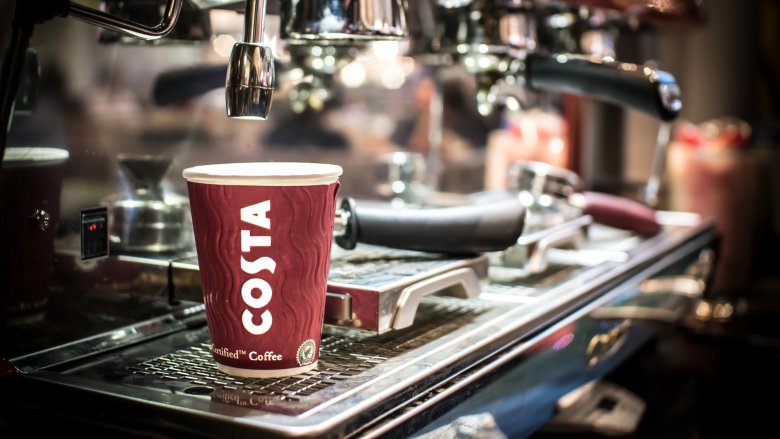The Untold Truth Of Costa Coffee
Coca-Cola's recent $5.1 billion purchase of Costa Coffee from UK's hotels and drinks group, Whitbread, may have caught some people in the United States off guard... primarily because they may not know much about Costa. That's about to change.
Costa Coffee is a British-based coffee conglomerate, but it hasn't made a name for itself in the United States. Does Coke's takeover mean Starbucks has something to worry about?
"There's opportunity for great value creation, through the combination of Costa's capabilities and Coca-Cola's marketing expertise and global reach," James Quincey, Coke's CEO said.
The deal hasn't yet been finalized — there are a lot of shareholders and regulators that still need to have their say — but it's expected to be completed by summer 2019. Regardless of their exact plans for the company, Coke's ownership is sure to grow brand awareness of Costa Coffee. Let's get to know a bit more about Costa before it starts making waves.
It's one of many recent beverage company deals
Coca-Cola's $5.1 million purchase of Costa Coffee normally would generate a lot of buzz, just from its sheer size. But in the world of beverage companies, it's just another huge deal. The biggest recent deal occurred between Nestle and Starbucks. Nestle leads the world in packaged coffee, and it has agreed to a licensing deal for $7 billion with Starbucks for its retail business.
Pepsi, Coca-Cola's biggest competitor in the soft drinks arena, recently announced plans to purchase SodaStream for $3.2 billion.
JAB, which owns the Keurig brand, merged with Dr. Pepper Snapple this year, creating a soft drink and coffee powerhouse. This merger was an all-stock deal, but the combined company would've had $11 billion in revenue in 2017.
The size of the Coca-Cola purchase of Costa caught some investors off guard. Just a few months earlier, reports said a series of private equity firms were considering a purchase of Costa Coffee for more than $3 billion. Coca-Cola generated $9 billion in 2017, versus $312 million for Costa Coffee.
It's not Coca-Cola's first move into the coffee business
The purchase of Costa Coffee isn't Coca-Cola's first foray into the world of coffee, but it definitely will be the company's largest coffee option — and their only hot one.
Currently, Coca-Cola distributes and sells ready-to-drink iced coffees, such as Gold Peak cold-brew coffees, Dunkin' Donuts iced-coffee beverages, Monster Energy's hybrid coffee and energy drink, and McDonald's ready-to-drink McCafe Frappes. Coca-Cola also owns the Georgia ready-to-drink coffee brand that's sold in Japan.
With all of these acquisitions and distribution deals, Coca-Cola is continuing a pattern of reducing the percentage of sugary drinks under its umbrella, while increasing the ratio of more profitable beverages, like hot coffee and bottled water.
"It's more important than ever that Coca-Cola make a serious and significant investment in the category, because it's the right thing to do to serve our consumers with more of the drinks they want," says Coca-Cola CEO James Quincey, who mentioned in a letter to shareholders that the coffee category is growing 6 percent annually worldwide, which makes it attractive for Coke.
Costa Coffee has a ton of stores... but zero in the US
If you've never heard of Costa Coffee, you're not alone. After all, there aren't any in the United States. But elsewhere in the world, Costa has a significant presence. Coca-Cola hasn't announced plans to begin opening Costas in America, but that doesn't mean Costa Coffee won't start competing with Starbucks more aggressively elsewhere in the world.
Costa Coffee currently has about 4,000 store locations in 31 countries, including outlets in Europe, Asia, the Middle East, and Africa. The majority of Costa Coffee stores are in the United Kingdom, where the company had 2,467 locations in mid-2018.
Additionally, Costa has more than 8,000 on-the-go locations, called Costa Express, which offer self-serve coffee products. More than 7,200 of those stores are in the United Kingdom, so Coca-Cola has a lot of opportunities to expand both types of Costa stores worldwide, regardless of whether they bring it to the United States any time soon.
Costa actually has more Costa Coffee stores in Europe (about 2,750 stores) than Starbucks does (about 2,400 stores). But in the United States, Starbucks has more than 13,500 stores with Dunkin' Donuts second at more than 8,800 stores. No other coffee chain has even 1,000 stores in America.
Costa's sales have slowed recently
Costa Coffee has grown at an extremely high rate in the past couple of decades, making it a significant success story for its parent company, Whitbread.
Whitbread paid £19 million for Costa in 1995 (which translates to about $24.5 million at today's exchange rate). At the time Whitbread bought Costa, it had 39 stores. You could say it's had quite the growth spurt.
The recent sale to Coca-Cola was for £3.9 billion (or $5.1 billion). That's quite an appreciation over just two decades.
However, even though they've grown the company by billions, Costa's sales growth has slowed in the past few years. Total annual company sales growth slowed from about 24 percent in 2013 to about 11 percent in 2017. Like-for-like sales growth in the United Kingdom was about 7 percent annually in 2013, but only 2 percent in 2017.
They started really small
Costa Coffee may be worth billions of dollars today, but it started simply in 1971 as two brothers — Bruno and Sergio Costa — creating an Italian-style mocha coffee blend they began selling in the UK. They used the family's original roaster from Italy, a relic from an old family coffee roasting business. When creating its coffee today, Costa Coffee continues to use a technique similar to what the Costa brothers used.
After the number of people buying their coffee blend to brew at home began to grow, the brothers decided to open a coffee store in 1978 in Vauxhall Bridge, London, bringing a true Italian experience to coffee lovers. They worked together for a few years, before Sergio bought out Bruno's share in 1985. Sergio later sold the company to Whitbread in 1995, but Bruno received very little money from that sale.
The new owners quickly took Costa Coffee international, opening a store in Dubai in 1999, the first store outside the United Kingdom and Europe. Costa's first store in China was opened in 2007 in Shanghai City.
One of the co-founders no longer drinks Costa's coffee
Bruno Costa, one of the co-founders of Costa Coffee, no longer drinks the company's coffee, even though he still loves to drink coffee he makes at home.
In an interview with his local paper (via Daily Mail), Bruno Costa said he's not bitter about selling his share of the company to his brother in 1985, who later turned a big profit by selling the company to Whitbread. However, Bruno Costa does say he regrets having sold his share, because he dislikes seeing large chains monopolizing the industry and driving out independent brewers.
Because Bruno Costa lives relatively modestly in London, people are surprised when he tells them he was a co-founder of Costa Coffee.
"Dad's not a recluse, but he has a very normal existence," his daughter, Sonia, said in an interview. "When he tells people his name, they sometimes ask if it's anything to do with the coffee company, and can never believe it when he says, 'yes.'"
Despite his deep coffee roots, he makes his brew in his own kitchen, with an inexpensive Nespresso machine.
They have tables just for lonely people
One is the loneliest number, so Costa Coffee is out to reduce the number of singles sitting alone in its stores. In 2018, Costa announced plans to introduce chatter and natter tables in 300 of its stores in Britain.
Costa says the tables will be reserved for people who'd normally enjoy their beverage alone, allowing them to sit with other singles for conversation, whether it's for a few minutes or half the morning.
In Britain, one study said 11 percent of men admitted to being lonely on a daily basis, and 35 percent of men said loneliness leads to depression. Costa is doing their part to diminish those numbers.
And if you're looking for something interesting to talk about with a stranger at the chatting table, consider copying Sam Cooper, who loves Costa Coffee so much that he tattooed his right forearm with a replica of Costa's heat-proof coffee cup. (That ought to be worth a couple of free mochas you could share at the chatter and natter table.)
Some towns have fought to keep Costa Coffee away
Costa Coffee certainly has grown quickly with new stores opening almost every day somewhere in the world. But that doesn't mean everyone is happy about the growth of the company.
In 2016, a few towns in the United Kingdom had organized protests against Costa's plans to open stores in Dartmouth, Crediton, and Milford Haven. Protestors feared the introduction of a chain store like Costa could take business away from independent store owners.
"My fear is Costa can afford to run at a loss and undermine independent cafes," town councillor and cafe manager, Daniel Webb, told Daily Mail.
Totnes in Devon had one of the first successful protests against Costa Coffee in 2012, where almost 6,000 of the town's 8,500 residents signed a petition, hoping to maintain the town's tradition of independent business ownership.
Other towns have been more than happy to see a Costa Coffee open, especially in areas with high unemployment. In 2013, a new Costa store in Nottingham drew 1,701 applications for just eight positions.
Costa Coffee's official taste tester insured his tongue
Lloyd's of London is famous for insuring odd items that other insurers usually won't touch, so it probably stands to reason that when an expert coffee taster would be looking to insure his or her tongue, Lloyd's of London is the first choice.
Gennaro Pelliccia (pictured), the chief taste-tester at Costa Coffee, insured his tongue and taste buds for $13 million in 2009.
"In my profession, my taste buds and sensory skills are crucial," Pelliccia said. "My taste buds also allow me to distinguish any defects, which enables me to protect and guarantee Costa's unique Mocha Italia blend."
At the time of issuance, the policy for Pelliccia was one of the largest Lloyd's had ever issued for a body part, trailing the $56 million policy for David Beckham's legs and the $35 million policy for dancer Michael Flatley's legs.
They have an ambitious cup recycling program
If you love to-go coffee but dislike the idea of all of the waste those cups cause, you'll appreciate Costa Coffee's recycling campaign.
The company has adopted a policy that it hopes will see as many as 500 million takeaway cups recycled every year by 2020. This number would be roughly equal to the number of cups Costa itself would sell.
"By the end of 2020, we'll effectively be cup-neutral. We'll be recycling as many cups as we put into the system," Costa managing director Dominic Paul told BBC.
To achieve this goal, Costa Coffee plans to pay recyclers and waste collectors in the United Kingdom a premium for coffee cups they collect versus traditional recycling fees they'd receive. The program would accept both Costa cups as well as competitors' cups.
In addition, Costa Coffee's paper cups are made from sustainable wood pulp from forests in northern Europe.
They're so innovative, they have drones
Costa is an environmentally conscious company that, aside from their to-go cup recycling program, has committed to replacing plastic straws (like many American companies) and eliminated plastic stirrers many years ago.
Additionally, Costa's coffee is 100 percent Rainforest Alliance certified, which means the beans only come from farms that manage their land and grow crops in a way that cares for the land properly.
Costa's biggest innovations aren't all about environmental issues, though. The company knows how to have fun, too, and they're not afraid to show it. Costa Coffee tested a Drone Drop service with one of its branches in Dubai, where customers at the beach could order a drink and have it delivered in 15 minutes via drone.
No word on whether the drone was equipped to carry a tip back to the barista, or whether they'll be implementing those drones in other locations. If they do, traffic jams may never be the same again.
Costa Coffee goes all out for Christmas
For the past several years, Costa Coffee has introduced a Christmas menu a couple of months before the holidays, consisting of special foods, drinks, and holiday decorated cups.
For the first Christmas menu in 2013, Costa provided cup designs named Father Christmas, Snowman, Gingerbread Man, and Elf. Additionally, any customer who ordered a specialty Christmas drink received free food if they were also wearing a Christmas jumper.
Customers loved the campaign, and the coffee giant has continued making it bigger each year since. In 2015, Costa added Penguin and Robin cups to the lineup. They changed the cup design further in 2017, creating cups featuring characters as Christmas tree ornaments.
Customers had begun to enjoy the Christmas-themed food and drinks so much that removal of the holiday white hot chocolate drink from the Christmas menu in 2017 caused Twitter outrage, including calls of "worst Christmas ever" and "Christmas is ruined." (Because we know Twitter users are never, ever prone to overreaction and faux outrage, we're just hoping Costa's new Christmas menu can find a way to save Christmas for 2018.)
They're always up for something new
One reason customers keep coming back to Costa Coffee is because of all of the different drinks and foods it offers. Costa keeps old favorites, but new drinks are constantly debuting.
In summer 2018, for example, Costa began offering Frostino blended iced drinks that could be made with or without coffee, including a new salted caramel crunch.
In the spring of that same year, Costa introduced its Flat Family line of drinks, which included a caffeinated flat black drink. "Each member of the Flat Family is handcrafted by an expert barista using the purest coffee extraction method, a cortissimo shot," the Costa press release said.
After reading the description of the drink though, several Twitter users mocked Costa, deciding this drink was simply plain black coffee with a fancy name to justify a higher price.
Costa's man with the £10 million tongue, Gennaro Pelliccia, disagrees, calling Flat Black a "pure coffee," but, as everyone knows, it's tough to win an argument with sarcastic Twitter users.
